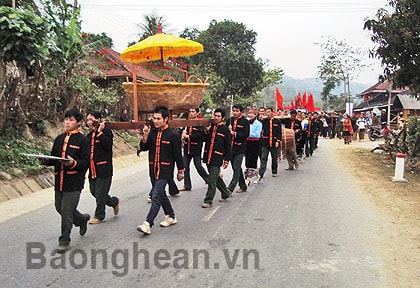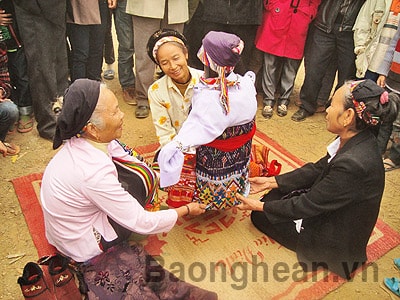Solutions to preserve cultural identity of ethnic groups
(Baonghean) -Tom and Lam singing melodies are tending to be forgotten; traditional costumes of Mong, Thai, and Kho Mu ethnic groups are now only easily found in festivals; customs and practices have begun to change… That is the reality of preserving the cultural identities of ethnic groups in Ky Son district.
Ky Son district currently has 5 ethnic groups living together, including: Mong, Kho Mu, Thai, Kinh and Hoa. Each ethnic group has different customs and traditions, creating a diversity and richness of cultural colors. Coming to Ky Son, you will enjoy the typical performances of ethnic groups such as: xuoi, xap, lam, nhuon, and nhay sap of the Thai ethnic group; tom singing and gongs of the Kho Mu ethnic group; cu xia, lu tau, and pipe-blowing dance of the Mong ethnic group.
The intangible and tangible culture of Ky Son district is also extremely rich with the folk literature treasure of the Thai ethnic group, festivals such as: Xang Khan Festival of the Thai ethnic group, New House Celebration of the Khmu ethnic group, Bull Fighting Festival, traditional weddings of throwing con, pushing sticks, tug of war, crossbow shooting, buffalo fighting, swing of the Mong ethnic group. In Na Luong village, Huu Kiem commune, Pu Nha Thau Temple (Tran Dynasty Temple) was granted a Certificate of Historical and Cultural Relic by the Provincial People's Committee in 2009. The temple was built by the people in the 14th century and restored in the 19th century to worship General Doan Nhu Hai and the old woman who raised the army, encouraged her husband and children to fight the enemy, and protected the border. Pu Nha Thau Temple Festival in early spring every year is a traditional cultural beauty of the Ky Son ethnic groups.

Pu Nha Thau Temple Festival (Na Luong village, Huu Kiem commune)
However, over time, combined with the influx of many different cultures, the cultural values of ethnic minorities in Ky Son district are showing signs of fading. If you witness a Xang Khan ceremony of the Thai ethnic group in Ky Son, the Thai people who still wear their traditional costumes are very few. Those who still keep them are mostly elderly people. Even the musical instruments associated with the Thai ethnic group such as the panpipe, flute, and mouth flute are gradually disappearing. The number of people who can play the panpipe can be counted on the fingers. Mrs. Vi Thi Dau, Hoa Son village, Ta Ca commune is one of the few people in the commune who still knows how to sing lam (traditional singing of the Thai ethnic group). Although she is old, she still sings at almost every festival. She said: I want to pass on my singing to the younger generation so that when there is a festival, they can sing. But no child has agreed yet.

Costumes of Thai ethnic people in Ky Son.
The same situation also occurs for the Mong and Khmu ethnic groups. According to Mr. La Pa Vin, Vice Chairman of the People's Committee of Ta Ca commune, the values of cultural identity are decreasing at a sad rate. For the Mong people, at festivals, people still organize activities such as throwing con, bull fighting, but with cu xia singing, the traditional singing, the number of people who know how to sing is only a few. In particular, no one in the young generation knows how to sing. Musical instruments such as flutes, panpipes, and drums only appear sporadically in some families.
The Mong people's costumes have many innovations, in a more convenient direction for daily life. "Currently, for the Mong people, only two cultural features, bull fighting and playing the flute at funerals, are still intact, while other cultural features have changed a lot, some have almost disappeared. For example, the traditional house of the Mong people has pillars buried deep in the ground, the roof is made of samu wood, but the whole commune only has 3 houses like that. Then there are only 2 households still doing the traditional blacksmithing. For the Khmu people, the loss of identity is happening most strongly. The stilt houses are gradually disappearing, replaced by level 4 houses with dirt floors. The Khmu people have Tom singing, but the number of people who know how to sing is not many anymore."
The above situation is happening quietly but strongly in Ky Son. It is not difficult to explain this, because in the era of rapid information technology explosion and convenient transportation like today, the exchange and absorption between cultures is natural. Although ethnic minorities have been mobilized and propagandized to preserve and conserve the cultural identity values of their own people, when economic conditions are extremely difficult, that goal is very difficult to achieve.
Mr. Mong Thai Nhi - Head of the Culture and Information Department of Ky Son district shared: 97% of the district's population is ethnic minorities. In recent years, many cultural values of ethnic groups are gradually fading away. The few artisans who can still sing traditional songs are getting older, while the young generation is not interested. Whenever a festival or cultural activity is organized, the district requires participating groups to wear their ethnic costumes, partly to help people realize their role and responsibility in preserving and conserving their ethnic cultural identity.
The work of preserving, conserving and promoting the cultural identity of ethnic groups has been focused on by authorities at all levels in Ky Son. In 2009, the district opened two classes to teach folk music and dance with the aim of letting the young generation know the dances and songs of their ethnic groups. In 2011, the district's Department of Culture and Information coordinated with the Provincial Ethnic Song and Dance Troupe to collect, film and record dances, songs, costumes, and customs in three villages, typical of the three ethnic groups Thai, Kho Mu, and Mong. In 2012, the district coordinated with the University of Culture to organize the preservation of the cultural values of the Kho Mu people in Huoi Tho village (Huu Kiem commune). The main content is to restore festivals of the Khmu ethnic group such as weddings, housewarming, new rice celebrations, etc. The above works have had certain effects, and most importantly, have changed the awareness of some ethnic groups in preserving the cultural features of their ethnic group.
However, these are just measures that have not been effective and widely replicated. Because the work of preserving and conserving cultural identity is not done in a day or two, but it is a long-term process, requiring investment in both material and human resources and the enthusiasm of cultural officials and local government leaders. Ms. Cut Thi Nguyet - Vice Chairman of the District People's Committee said: Currently, the team of cultural officials from the district to the commune is very small, not meeting the actual needs. Moreover, the State's investment budget for preservation and conservation work is still limited, even non-existent. In addition to the people's lack of awareness, even the Party committees and authorities at all levels have not considered this work as a separate task of the cultural sector. Building a diverse, rich and unique cultural life will be a great driving force for the process of economic development, strengthening solidarity between ethnic groups, maintaining national defense - security, political and social stability.
Article and photos: PB






